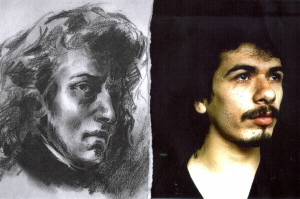- Moonlight my ass!
- The HUMBLER
- Who’s the top-selling pianist in history?
- Fly Away :(
- The Mozarts of Hair Metal
- How To Compose Today
- What time is it?
- Twins separated at birth
- To hear the world in a single note and heaven in a triad
- RIP Elliott Carter, Maestro of Thorny Complexity
- Monster Mashup
- May the best man wi… Oh, damn!
- Music for driving into trees: Sweet Wine
- Music for driving into trees
- My Favorite Things
- Mammas Please Let Your Babies Grow Up to Play Cowbells
- Claret for Clara
- Last of the Bohemians
- Guy walks into a bar
- How to break a heart with one chord
- What are oboes good for?
- Doppelganger
- Enigma

Twins separated at birth?
Doppelganger
March 01, 2010
It's Doppelganger Week, when folks swaps faces for faces. Got me wondering: How about Doppelganger music?
Try this out: Play Chopin’s G Minor Ballade. Then before you exhale, put on Santana’s Europa.
For me, these two pieces are spiritual twins. I’ll try to make the case.
● They take you on the same ride. Slow and soulful at the start, the water breaks, then breathless crazed fury at the end. In a double-blind placebo-based randomized trial of listeners, cardiologists have measured the difference in heart rate between start and finish. In both instances, an increase on 45 beats per minute.
● The ride starts the same. An upward arching four-note minor-key phrase, a plea to the heavens, coming to rest on sustained notes that serve only as question marks hanging in the air.
● The ride continues along the same line. That initial phrase is sequenced a few times, adding to the pain and tension. And so it goes till near the end, when…
● All hell breaks out. The lions’ cages unlocked a feeding time. Skiing off a cliff. Freefall frenzy. Unfettered exhuberance. Full-tilt freakout.
But these parallels don’t really make the case. It’s more than the expressive arc. More than the heart-piercing harmonic and melodic language.
For me, these two pieces were drawn from the emotional well, inspired by the same muse, and tell the same story, whatever that might be. So all this half-diminished case-making is a musicologic fool’s game. Why are the Ballade and Europa dopplegangers? Because I feel it.
Next time: First movement of Beethoven’s Emperor Concerto and Hendrix’s House Burning Down.
So… What are your musical dopplegangers?
Oh… and happy 200th birthday, Piano Man.
Categories: Composers, Chopin, Musicians, Santana, Unified theory of music